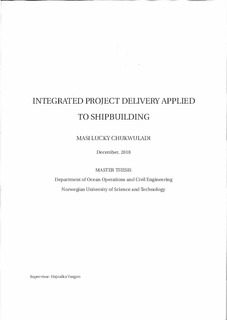| dc.description.abstract | Using a classical or system-based design approach, tp.e naval architect in consultation with a ship-owner, develops a concept for a vessel and a contract is entered into between the design team and the ship-owner. The design team progresses to concept design and basic design and then, a tender is opened for shipyards to bid for the building contract. The nominated shipyard then in consultation wit)J. the design consortium, develops a contract design, detailed and subsequently production design.
These sequencing where the yard is not part of the concept development and design, generates fragmentation in the flow of the design information. Also, the process of design and production follows a concurrent engineering approach where overlapping of activities are visible. Such Overlap and design fragmentation creates to a large e:xtent project uncertainty which is triggered by the design and planning/production separation, engineering concurrency and often a third factor originating from the continuous dialogue between the ship-owner and the design team and the gross effect is a shipbuilding project with time and cost overruns.
To salve the problem, the master's thesis embarked on a mixed research method, exploring to determine the prerequisite measures needed to apply Integrate Project Delivery to Shipbuilding and through its features of collaboration, project uncertainty could be controlled. Combining multiple literature survey to generate broad opinion which would provide a foundation for a semi-structured interview. The interview were conducted within More og Romsdal region of Norway and provided the author with industry related account on how IPD could be used to achieve stakeholders integration, information sharing and retrieval.
The findings as presented in the result section, suggest that applying IPD to a shipbuilding project would require re-organizing the design process workflow, allowing yard participation at the point of project conceptualization, approach the concept development of the vessel through a collaborative means, adopting a communication protocol that spells out responsibility to parties and to project and approaching design either through a collaborative approach or a pull-back formation.
On the problem of uncertainty, a design delay period was introduced in-between major milestones to test phase accomplishments and design outcomes in accordance to a defined Level of Detail (LoD) in the protocol, integrated the stakeholders and adopting a multi-disciplinary approach to qualifying design change requests from ship-owner before implementation. | nb_NO |
